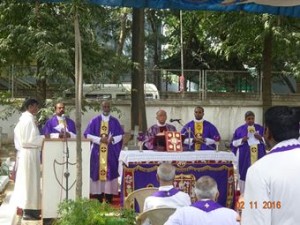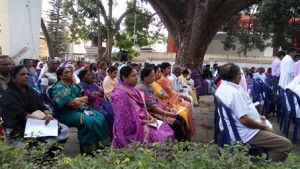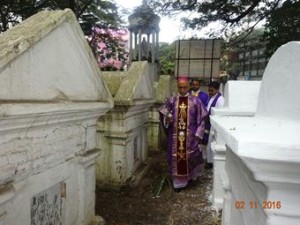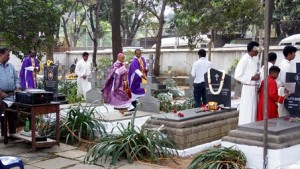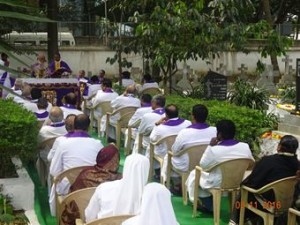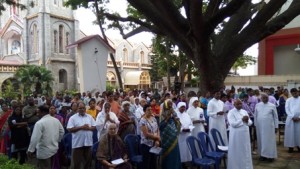Archbishop Moras Blesses Priests’ Cemetery; speaks mind of the Church on ‘Burial and Cremation
Bengaluru, Nov 2: Priests, religious and laity gathered on All Souls Day, 10.30 am at the Sacred Heart Church Priests’ cemetery for a mass for the commemoration of deceased priests who served in the Archdiocese of Bangalore. Archbishop Rev. Dr. Bernard Moras in his homily informed the congregation of the latest document of the Congregation for the Doctrine of the Faith titled Ad resurgendum cum Christo (To Rise with Christ) “regarding the burial of the deceased and the conservation of the ashes in the case of cremation.”
Drawing reference to the salient features of the document the Prelate emphasized at the very outset that nothing has changed in Church teaching but the document is a restatement of previous guidelines due to the widespread mishandling of cremated remains. He informed the gathering that The Congregation for the Doctrine of the Faith has deemed it opportune for the publication of a new Instruction, with the intention of underlining the doctrinal and pastoral reasons for the reference of the burial of the remains of the faithful and also to set out norms pertaining to the conservation of ashes in the case of cremation.
While the Archbishop announced that the detailed guidelines and instructions of the document will be published in the Archdiocesan Circular he pointed out to the salient features of the document saying “Following the most ancient Christian tradition, the Church insistently recommends that the bodies of the deceased be buried in cemeteries or other sacred places” and noted that “Burial is above all the most fitting way to express faith and hope in the resurrection of the body. By burying the bodies of the faithful, the Church confirms her faith in the resurrection of the body, and intends to show the great dignity of the human body”.
He observed “Burial in a cemetery or another sacred place adequately corresponds to the piety and respect owed to the bodies of the faithful departed who through Baptism have become temples of the Holy Spirit. The burial of the faithful departed in cemeteries or other sacred places encourages family members and the whole Christian community to pray for and remember the dead. Through the practice of burying the dead in cemeteries, in churches or their environs, Christian tradition has upheld the relationship between the living and the dead and has opposed any tendency to minimize, or relegate to the purely private sphere, the event of death and the meaning it has for Christians”.
Commenting on the subject of ‘cremation” Archbishop Moras said in the light of the Vatican’s instructions “In circumstances when cremation is chosen because of sanitary, economic or social considerations, this choice must never violate the explicitly-stated or the reasonably inferable wishes of the deceased faithful. The Church raises no doctrinal objections to this practice, since cremation of the deceased’s body does not affect his or her soul”.
“Thus” he noted “cremation, in and of itself, objectively negates neither the Christian doctrine of the soul’s immortality nor that of the resurrection of the body”. He reiterated “The Church continues to prefer the practice of burying the bodies of the deceased, because this shows a greater esteem towards the deceased” but he cautioned Catholics saying “Cremation is not opposed per se to the Christian religion under the condition that this choice has not been made through “a denial of Christian dogmas, the animosity of a secret society, or hatred of the Catholic religion and the Church”.
The Archbishop mentioned precautions and care to be taken in the event of cremation saying “In the absence of motives contrary to Christian doctrine, the Church, after the celebration of the funeral rite, accompanies the choice of cremation, providing the relevant liturgical and pastoral directives. When, for legitimate motives, cremation of the body has been chosen, the ashes of the faithful must be laid to rest in a sacred place, that is, in a cemetery or, in certain cases, in a church or an area, which has been set aside for this purpose, and so dedicated by the competent ecclesial authority.
The Prelate also cautioned Catholics that “the reservation of the ashes of the departed in a sacred place ensures that they are not excluded from the prayers and remembrance of their family or the Christian community. The conservation of the ashes of the departed in a domestic residence is not permitted”. He also said “It is not permitted to scatter the ashes of the faithful departed in the air, on land, at sea or in some other way, nor may they be preserved in mementos, pieces of jewelry or other objects. When the deceased notoriously has requested cremation and the scattering of their ashes for reasons contrary to the Christian faith, a Christian funeral must be denied to that person according to the norms of the law.
The animated by melodious Latin and English singing by seminarians from Bkahti Bhavan (Archdiocesan Minor Seminary) lead by its Rector Fr. Christopher Vimal Raj and Spiritual Director Fr. Lawrence Noronha was attended by 25 priests from across the Archdiocese.
While the Archbishop blessed the graves of the deceased priests, thousands of Faithful flocked to the cemeteries across the Archdiocese to attend masses offered by diocesan and religious priests.
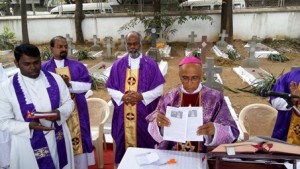
Our beloved Archbishop released a hand out on `Why do Catholics pray for the dead?`. The hand out is published and distributed by the Archdiocesan Communication Centre (ACC).

